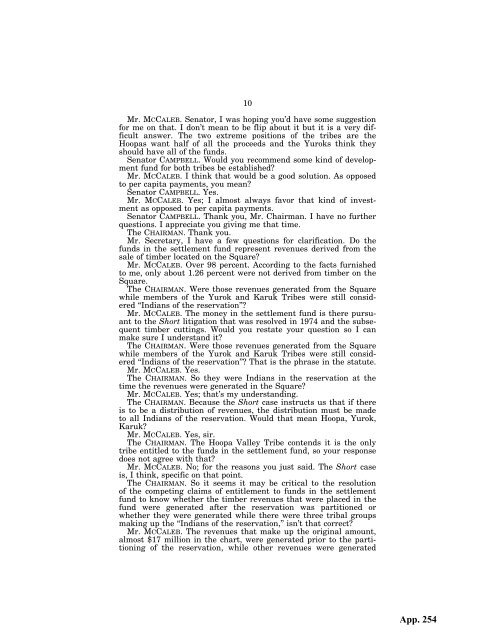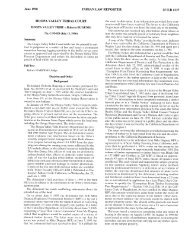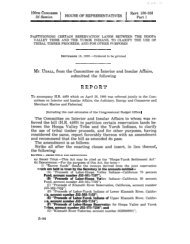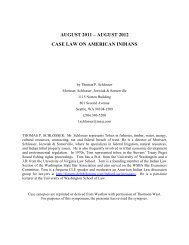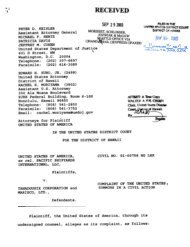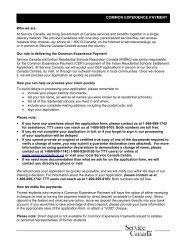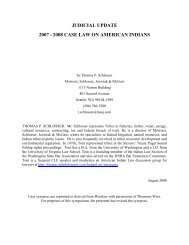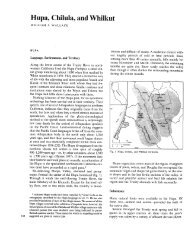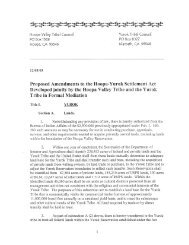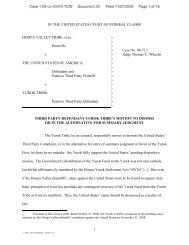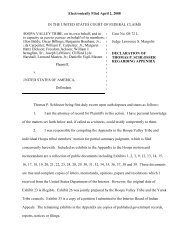Hoopa appendix supporting summary judgment - Schlosser Law Files
Hoopa appendix supporting summary judgment - Schlosser Law Files
Hoopa appendix supporting summary judgment - Schlosser Law Files
Create successful ePaper yourself
Turn your PDF publications into a flip-book with our unique Google optimized e-Paper software.
10<br />
Mr. MCCALEB. Senator, I was hoping you’d have some suggestion<br />
for me on that. I don’t mean to be flip about it but it is a very difficult<br />
answer. The two extreme positions of the tribes are the<br />
<strong>Hoopa</strong>s want half of all the proceeds and the Yuroks think they<br />
should have all of the funds.<br />
Senator CAMPBELL. Would you recommend some kind of development<br />
fund for both tribes be established<br />
Mr. MCCALEB. I think that would be a good solution. As opposed<br />
to per capita payments, you mean<br />
Senator CAMPBELL. Yes.<br />
Mr. MCCALEB. Yes; I almost always favor that kind of investment<br />
as opposed to per capita payments.<br />
Senator CAMPBELL. Thank you, Mr. Chairman. I have no further<br />
questions. I appreciate you giving me that time.<br />
The CHAIRMAN. Thank you.<br />
Mr. Secretary, I have a few questions for clarification. Do the<br />
funds in the settlement fund represent revenues derived from the<br />
sale of timber located on the Square<br />
Mr. MCCALEB. Over 98 percent. According to the facts furnished<br />
to me, only about 1.26 percent were not derived from timber on the<br />
Square.<br />
The CHAIRMAN. Were those revenues generated from the Square<br />
while members of the Yurok and Karuk Tribes were still considered<br />
‘‘Indians of the reservation’’<br />
Mr. MCCALEB. The money in the settlement fund is there pursuant<br />
to the Short litigation that was resolved in 1974 and the subsequent<br />
timber cuttings. Would you restate your question so I can<br />
make sure I understand it<br />
The CHAIRMAN. Were those revenues generated from the Square<br />
while members of the Yurok and Karuk Tribes were still considered<br />
‘‘Indians of the reservation’’ That is the phrase in the statute.<br />
Mr. MCCALEB. Yes.<br />
The CHAIRMAN. So they were Indians in the reservation at the<br />
time the revenues were generated in the Square<br />
Mr. MCCALEB. Yes; that’s my understanding.<br />
The CHAIRMAN. Because the Short case instructs us that if there<br />
is to be a distribution of revenues, the distribution must be made<br />
to all Indians of the reservation. Would that mean <strong>Hoopa</strong>, Yurok,<br />
Karuk<br />
Mr. MCCALEB. Yes, sir.<br />
The CHAIRMAN. The <strong>Hoopa</strong> Valley Tribe contends it is the only<br />
tribe entitled to the funds in the settlement fund, so your response<br />
does not agree with that<br />
Mr. MCCALEB. No; for the reasons you just said. The Short case<br />
is, I think, specific on that point.<br />
The CHAIRMAN. So it seems it may be critical to the resolution<br />
of the competing claims of entitlement to funds in the settlement<br />
fund to know whether the timber revenues that were placed in the<br />
fund were generated after the reservation was partitioned or<br />
whether they were generated while there were three tribal groups<br />
making up the ‘‘Indians of the reservation,’’ isn’t that correct<br />
Mr. MCCALEB. The revenues that make up the original amount,<br />
almost $17 million in the chart, were generated prior to the partitioning<br />
of the reservation, while other revenues were generated


